U.S. Department of Transportation
Federal Highway Administration
1200 New Jersey Avenue, SE
Washington, DC 20590
202-366-4000
http://safety.fhwa.dot.gov/ped_bike/pedforum/
The National Highway Traffic Safety Administration (NHTSA) has announced the availability of materials now live on their website (direct links are provided). Please note that these materials will only be made available electronically for you to download. NHTSA is working towards making the Child Pedestrian Curriculum and the Cycling Skills Clinic available in CD-ROM in the future. NHTSA permission to use the products is not necessary. To continuously improve resources, NHTSA welcomes your comments.
Child Pedestrian Curriculum: This national curriculum is designed to teach pedestrian safety to children in K-5th grade. It is divided into sections according to grades: K-1, 2-3, and 4-5.
Cycling Skills Clinic Guide: The Cycling Skills Clinic (formerly called the Bike Rodeo), is a resource encompassing recommended stations to include in any clinic. A variety of people (anywhere from service organizations, law enforcement officers, public health groups, to full-time bicycle safety advocates/ educators) are asked to support efforts to teach grade school children via this onbicycle activity. This step-by- step guide includes downloadable materials such as handouts, signs, station layout measurements, and guidelines for volunteers at each station, etc. NHTSA encourages adapting the use of this product for other older audiences.
Bikeability Checklist (in English and Spanish): This is a tool that assists the user in rating the safety and "bikeability" of their community. It helps identify problem areas that need attention.
Walkability Checklist (in English and Spanish): This is a tool that assists the user in rating the safety and "walkability" of their community. It helps identify problem areas that need attention.
Pedestrians Make Safe Choices: This activity is for older elementary school age children. It demonstrates the safe way to cross a street.
Bicyclists Make Safe Choices: This activity is for older elementary school age children. It demonstrates safe bicycling behavior.
A Secret Message (pedestrian): This activity is for children in the midelementary school age years.
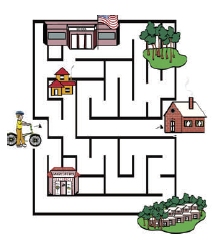
Get to School (and Back Again) Safely Game Board (ped/bike/ SRTS): This activity can be downloaded and played in small groups within the classroom to complement educational efforts to address safety regarding walking, bicycling and Safe Routes to School.
Paul's Amazing Trip (bicycle): This activity is for children in the midelementary school age years.
Traffic Safety Fact Sheets Bicyclists 2009: This is the annual NHTSA compilation of data facts related to bicyclist fatalities and injuries for the most recent year that full data is available.
Traffic Safety Fact Sheet Pedestrian 2009: This is the annual NHTSA compilation of data facts related to pedestrian fatalities and injuries for the most recent year that full data is available.
Traffic Safety Fact Sheet Children 2009: This is the annual NHTSA compilation of data facts related to traffic fatalities and injuries related to children for the most recent year that full data is available.
Coming soon:
Walk and Bike Safely: Beginning Level Curriculum for Adult English Language Learners. This product (currently in design) is in English with many pictures to teach the basics of pedestrian and bike safety for adults learning the English language. When complete, the product will be posted on both the NHTSA pedestrian site and the NHTSA bicycle site.
Pedestrian Safety Training for Law Enforcement Officers. This will be a CD-ROM training for officers. For information regarding these products or any other questions, please contact: Paula Bawer, Bicycle Safety and SRTS Program Manager for NHTSA, or Leah Walton, Pedestrian Safety and Pupil Transportation Program Manager for NHTSA.
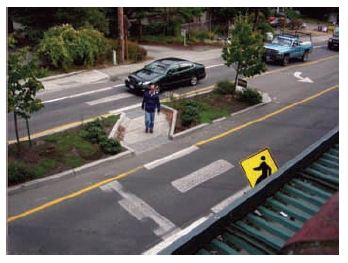
As mentioned in the Winter 2011 Pedestrian Forum Newsletter, the FHWA Safety Office released a memo two years ago strongly encouraging the states to adopt nine countermeasures that are proven to increase safety and implement them wherever it makes sense. There are two that are aimed specifically at improving pedestrian safety: medians/pedestrian refuge areas and walkways.
In order to assist engineers and practitioners in convincing policy makers to consider widespread use of these countermeasures, FHWA has undertaken a marketing effort aimed at drawing attention to the benefits of developing state/local policies.
Part of this effort consisted of hosting two webinars on the advantages of these countermeasures and how they can be implemented.
The webinars—which took place on Tuesday, May 3, from 2-4 p.m. EST and on Wednesday, May 4, from 11-1 EST— included presentations from state agencies that have developed policies on the use of medians/pedestrian refuge areas and walkways.
The webinars were recorded and will be posted shortly to the FHWA Safety website. You can either check the site or sign up for the e-subscription service, which will alert you to the posting of this recording as well as any new webinar information in the future.
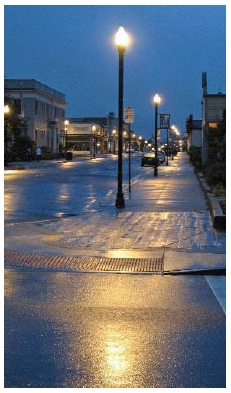 For
several years now, the FHWA Ped/Bike Safety Program has been offering free technical
assistance to its 13 Pedestrian Focus States and 5 Focus Cities. One of the
offered courses, Planning for Pedestrian Safety (also known as How to Develop
a Pedestrian Safety Action Plan), will be presented as 7 FREE webinars for up
to 1000 participants. The webinar series is intended to help communities address
pedestrian safety issues and initiate the steps for drafting a tailored pedestrian
safety action plan. The following topics will be addressed:
For
several years now, the FHWA Ped/Bike Safety Program has been offering free technical
assistance to its 13 Pedestrian Focus States and 5 Focus Cities. One of the
offered courses, Planning for Pedestrian Safety (also known as How to Develop
a Pedestrian Safety Action Plan), will be presented as 7 FREE webinars for up
to 1000 participants. The webinar series is intended to help communities address
pedestrian safety issues and initiate the steps for drafting a tailored pedestrian
safety action plan. The following topics will be addressed:
Session 1 – Course Introduction and General Planning Principles: presented by Peter Eun (FHWA), Ryan Snyder (Ryan Snyder Associates) and Paul Zykofsky (Land Use and Transportation Programs, Local Government Commission). April 26, 2011 – 1:00-3:00 p.m. EDT
Session 2 – Stakeholders: presented by Peter Lagerway (Toole Design Group), May 4, 2011 – 2:00-4:00 p.m. EDT
Session 3 – Data Collection and Analysis: presented by Charlie Zegeer (Pedestrian and Bicycle Information Center (PBIC)), May 18, 2011 – 2:00-4:00 p.m. EDT
Session 4 – Pedestrian Safety Education: presented by Nancy Pullen-Seufert, (National Center for Safe Routes to School). June 1, 2011 – 2:00 p.m. EDT.
Session 5 – Safety Enforcement: Craig Allred (FHWA) and Peter Flucke (We Bike). Date, time and registration information TBD.
Session 6 – Engineering: Hillary Isebrands (FHWA) and Michael Moule (Livable Streets). Date, time and registration information TBD.
Session 7 – Funding Issues: Keith Sinclair (FHWA) and Peter Lagerwey (Toole Design Group). Date, time and registration information TBD. AICP credit will be available for sessions 2-7.
To register for upcoming Webinars and find out about future Webinar dates as they are released, please visit www.walkinginfo.org/webinars.
This Webinar series is aimed at engineers, planners, traffic safety and enforcement professionals, public health and injury prevention professionals, and decision-makers who have the responsibility of improving pedestrian safety at the state or local level. Detailed information on this and other training opportunities offered by PBIC can be found at www.walkinginfo.org/training.
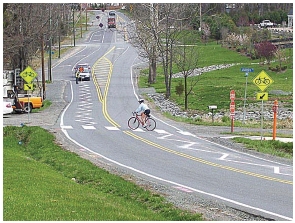
Zig Zag Markings at the Belmont Ridge Road/Washington and Old Dominion Trail Crossing (above) and Sterling Boulevard (below) in Loudoun County, Virginia.
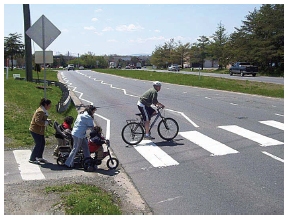
The Virginia Transportation Research Council (VTRC) recently completed a research study and documented it in a report entitled Best Practices in Traffic Operations and Safety: Phase II: Zig Zag Pavement Markings.
The report details the application of "zig zag" pavement marking in advance of two trail crossings at the Washington and Old Dominion (W&OD) Trail at Belmont Ridge Road and Sterling Boulevard in Loudoun County, Virginia (shown in pictures at right). These markings are used in Europe to warn drivers of a potential pedestrian crossing, but are not in use in the United States. Accordingly VTRC requested permission from FHWA to experiment with the markings and determine their effectiveness. Effectiveness was defined in three ways:
The study found that the markings heightened the awareness of approaching motorists. This was evidenced by reduced mean vehicle speeds within the marking zones. Further the majority of survey respondents indicated an increase in awareness, a change in driving behavior, and a higher tendency to yield than before, and the markings had a sustained positive effect on speed reduction.
The study also found that both road and trail users have limited understanding regarding the purpose of the markings and are confused regarding who has the right of way at the crossings.

Tamara Redmon, Pedestrian and Bicycle Safety Team Leader
Federal Highway Administration
1200 New Jersey Avenue SE
Room E71-303
Washington, DC 20590
Phone: 202-366-4077
Fax: 202-366-3222
E-mail: tamara.redmon@dot.gov
This Pedestrian Forum is available on the Web at http://safety.fhwa.dot.gov/ped_bike/pedforum/
To receive information on future newsletters, please use the e-subsciprtion service provided on this site: http://safety.fhwa.dot.gov/esubscribe.cfm#ped. Scroll down to “Pedestrian and Bicycle Safety” and select “subscribe” next to “Pedestrian Forum.”

Livable communities are a high priority of the U.S. Department of Transportation and the Obama Administration. A livable community is one that provides safe and convenient transportation choices to all citizens, whether it’s by walking, bicycling, transit, or driving. Each year, unfortunately, pedestrian fatalities comprise about 12 percent of all traffic fatalities and there are approximately 4,000 pedestrian deaths. Another 70,000 pedestrians are injured in roadway crashes annually. The numbers are improving, but we still have a ways to go. Pedestrian safety improvements depend on an integrated approach that involves the four E’s: Engineering, Enforcement, Education, and Emergency Services. The Pedestrian Forum highlights recent pedestrian safety activities related to the four E’s that will help save lives
*********************************
Creating Livable, Accessible Communities by Completing Our Streets. Enroll now in this free, two-part webinar event, Creating Livable, Accessible Communities by Completing Our Streets, part of the Selected Topics on Accessible Transportation series. Barbara McCann, Executive Director of the National Complete Streets Coalition, and Michael Ronkin, an expert in street design, will examine the principles of the complete streets movement and the ways the current trend toward creating livable communities translates into improved transportation options for people with disabilities, as well as the general public.
Part one will occur May 18 at 2 p.m. EDT and part two will occur May 25 at 2 p.m. EDT. Registration deadline: May 11.
